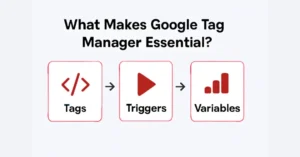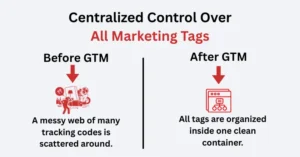
Running a website means juggling countless tracking codes, analytics snippets, and marketing tags. Tired of waiting on developers to add the Facebook Pixel or update Google Analytics? Google Tag Manager could be the answer you need.
This powerful tool changes how you track your website. It consolidates all your tags into a single, intuitive interface. Google Tag Manager makes management easy.
Short Intro
Google Tag Manager is a free tool. It helps you manage and update marketing tags on your website. And you can get it done without writing a single line of code. It brings all your tracking codes together. This cuts down on reliance on developers and offers strong debugging tools. Perfect for business owners and marketers. Get quick setup and improved site analytics control.
What Makes Google Tag Manager Essential?

GTM completely changes the way websites manage third-party tags and tracking codes. This free platform is a central hub. Here, you can manage all your marketing tags. You can manage Google Analytics and Meta Pixel tags with minimal effort. There’s no need to alter your website’s HTML.
The system has three main parts. These parts provide a large improvement in the efficiency of tag management.
Tags represent snippets of code that collect data from your website.
Tools include:
- Google Analytics for tracking.
- Facebook Pixel for social ads
- LinkedIn Insight Tag for B2B marketing
Triggers determine when your tags should fire. You can set triggers for:
- page views
- form submissions
- scroll behavior
- specific user actions, such as video player engagement.
Variables store information essential for the proper functioning of tags and triggers. They can track everything from page URLs to custom data layer values. This makes your tracking more precise and useful. If you want a detailed guide on setting up event-based triggers, check out this GTM event tracking guide.
How does Google Tag Manager benefit your business?
The advantages of implementing Google Tag Manager extend far beyond simple convenience. This platform transforms your entire approach to website analytics and marketing optimization.

Centralized Control Over All Marketing Tags
GTM simplifies tracking codes. It combines them into one manager container. You can see, change, and manage all your tags from one dashboard. This helps keep your marketing consistent.
Lightning-Fast Deployment Without Developer Delays
Want to set up conversion tracking for your new Google Ads campaign? GTM lets you add new tags in minutes. You don’t have to wait days for developers. This speed advantage becomes crucial during time-sensitive marketing campaigns.
Enhanced Error Checking and Debugging Tools
Google Tag Manager has built-in debugging tools. These tools help you spot issues before they impact your data collection. Preview mode allows you to test changes without risk. Error checking ensures the correct activation of your tags in various situations.
Reusable Templates for Consistent Implementation
The Community Template Gallery gives you ready-made solutions for common tracking tasks, helping you work faster and avoid mistakes. They work for server-side tagging and auto-event tracking.
What are the key implementation steps?
Setting up GTM needs careful planning. But it brings benefits shortly after proper setup. The process involves several critical steps that ensure optimal performance.
First, create your Google Tag Manager account. Then, install the container code on your website. This setup replaces the need for individual tracking codes in your HTML. Your local web developer can handle this initial installation if needed.
Next, set up your key tags. This includes Google Analytics and any ad tools you use. Start with simple page view tracking. Then, move on to more complex user actions and track conversions.
The data layer setup deserves special attention as it enables sophisticated tracking capabilities. This feature allows you to pass custom information from your website directly to your marketing tags. This boosts data accuracy in all your analytics platforms.
Which use cases deliver the most value?
GTM shines in situations that often trouble business owners and marketers. Understanding these use cases helps you maximize the platform’s potential.
Google Analytics integration
With Google Tag Manager’s built-in templates, setting up complete site analytics is simple and hassle-free. You can track page views, user actions, and custom events. Best of all, you don’t need to change your website’s code.
Social Media Advertising Optimization
Using Google Tag Manager for Facebook Pixel and LinkedIn Insight Tag helps you gather data for social ad campaigns. This approach ensures consistent data collection. The platform handles pixel firing timing and prevents conflicts between different marketing tags.
Advanced Conversion Tracking
With Google Tag Manager, you can track key user actions and adapt your tracking to fit your business goals. This includes form submissions, product purchases, and video engagement.
Multi-Environment Testing
Test changes using the platform’s container versions to ensure safety before launching. This capability proves invaluable when managing complex tracking setups across many product accounts.
What challenges should you consider?

Google Tag Manager has many benefits, but you should watch out for pitfalls. These pitfalls can hurt your data quality.
Security and Privacy Compliance
Third-party tags can introduce security vulnerabilities if management is inadequate. Set clear user permissions. Check your tag collection at regular intervals to maintain strong security. Cookie consent management becomes more complex when many marketing tags collect user data.
Technical Complexity Growth
As your GTM setup expands, keeping your tags, triggers, and variables organized becomes essential. This helps manage their dependencies in a way that maximizes efficiency. Document your configuration choices and maintain clear naming conventions for long-term success.
Staying Current with Platform Updates
Google regularly adds new features and improvements to Tag Manager. They also add new capabilities, like server-side tagging. Divide time for ongoing education to maximize the benefits of these improvements.
Where can you learn more?
Mastering GTM requires ongoing education and practice with real-world scenarios. Several high-quality resources support your learning journey.
Google’s Analytics Academy offers detailed courses. They cover basic setup and also advanced custom code implementation. These courses include practical exercises and real code samples that reinforce key concepts.
The official Google Tag Manager documentation has detailed guides. They cover specific use cases, like tracking mobile apps and integrating CRM platforms. Industry blogs and webinars regularly share new best practices and techniques.
Final Thoughts
GTM represents a fundamental shift toward more efficient, flexible website analytics. This platform helps you track codes in one place. It reduces your need for developers. So, you can respond to marketing changes without delay and gather data.
The initial setup investment pays off. It leads to faster implementation, better data accuracy, and improved debugging. GTM is useful for everyone. Whether you have a small business site or need advanced tracking for a large company, it works for you.
Begin with a basic Google Analytics setup. Then, as you feel more confident, add more advanced tracking. You’ll see quick benefits from better tag loading. Plus, you’ll have a central way to manage your marketing efforts.
FAQs
Google Tag Manager (GTM) is a free tool from Google that lets you add, edit, and manage tracking tags without touching your site’s code. It works with Google Analytics, Facebook Pixel, and more. Learn more about GTM setup at wixpa.com.
Using GTM saves time, reduces developer reliance, and improves tracking accuracy. You can update tags directly in its dashboard without code edits. For Shopify store owners, the Wixpa Tag Manager app makes integration simple and quick.
GTM enables fast tag deployment, central management, and better site performance through efficient tag firing. Its built-in debugging tools ensure accurate data. Marketers can launch campaigns quickly and adapt tracking without delays or coding.
GTM works by installing a container code on your site. Inside its dashboard, you set up tags (tracking codes), triggers (rules), and variables (data points). GTM evaluates triggers and fires the right tags automatically, keeping tracking flexible and organized.
GTM is designed to be beginner-friendly, with templates for popular tools and minimal coding after setup. Once installed, you can add or update tags quickly. The preview and debug tools ensure everything works correctly before publishing.





